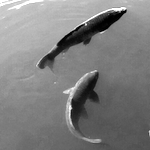Adult whirligig beetles (Coleoptera: Gyrinidae) are among the best swimmers of all aquatic insects. They live and feed mostly at the water's surface and their capacity to swim fast is key to their survival. Wave and viscous drag that they face can be modelled thanks to linear wave theory and Blasius boundary layer theory. The total drag they faced is nonmonotonous with speed. The speed regimes that they can access is determined by the total drag and the thrust capacity of their oars locomotory apparatus. A dichotomy between a low and a high-speed regime can then be explained, in line with trajectory recordings. However, the high speed regime appears only accessible to a given size range. The body length of the whirligig beetle species is indeed concentrated around 6.25 mm, whereas larger-size genera appeared only lately in evolution. The size of these beetles appears strongly constrained by the fluid mechanical laws ruling locomotion and adaptation to the water-air interface.
|
|
|
|
Constrains Over Whirligig Beetle Body Size Due to Water-Air Interface Physics
1 : Institut de Physique de Nice
Centre National de la Recherche Scientifique, Université Côte d'Azur
2 : Northern Arizona University [Flagstaff]
3 : Institut de recherche sur la biologie de l'insecte UMR7261
Université de Tours, Centre National de la Recherche Scientifique, Centre National de la Recherche Scientifique : UMR7261
|

 PDF version
PDF version
